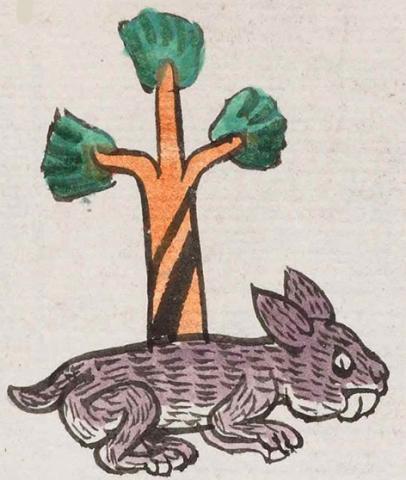Cuauhtochco (Mdz17v)
The Codex Mendoza has three glyphs for the place name Cuauhtochco (perhaps "In the Rabbit Wood") and they all look quite similar. They are found on folios 8 recto, 17 verso, and 48 recto. Like this one, they all have a tree (cuahuitl) and a rabbit (tochtli), producing the noun stems of cuauh and toch. The rabbit in this glyph is shown in profile, facing to the right, crouching slightly. Its coat is purple fading to white on its belly. Its eye (white) is open and some of its teeth (also white) are visible. The tree has one vertical stem and two branches, each with a clump of green foliage. The tree has parallel, diagonal stripes, one thin and one thick, painted black across the trunk. The locative suffix, -co, is not shown visually.
Stephanie Wood
Berdan and Karttunen give significantly different interpretations of this place name. There is some sense to a reading of "woods" over "tree(s)" from the cuauh- stem, and thus the rabbit would be of the woods, i.e. wild, as Karttunen suggests. Keiko Yoneda (Mapa de Cuauhtinchan, 2005, 2:242) supports this reading, saying that a cuauhtochtli is a "conejo de monte." But there may be a cuauhtochtli that is rabbit-like squirrel that lives in trees. Cecilio Augustín Robelo (Diccionario de Aztequismos, 1904) suggests "una especie de ardilla que vive en los árboles."
The black stripes (tlilcuahuitl) on the tree trunk are phonetic indicators that this sign is a tree (cuahuitl), something I discovered independently, but which has also been pointed out by Brígida von Mentz ("De árboles, raíces, y locativos en la iconografía del México antiguo," Tlalocan 15, 2008, 216–219).
There was a Quauhtochco in the contemporary state of Veracruz, but the name has been changed to Carrillo Puerto. Surely other communities still bear this name.
Stephanie Wood
quauhtochco. puo
Cuauhtochco, pueblo
Stephanie Wood
c. 1541, or by 1553 at the latest
Stephanie Wood
rabbits, squirrels, trees, woods, conejos, ardillas, árboles, monte, Quauhtochco, nombres de lugares

cuahui(tl), tree, https://nahuatl.wired-humanities.org/content/cuahuitl-1
toch(tli), rabbit, https://nahuatl.wired-humanities.org/content/tochtli
-co (locative suffix), https://nahuatl.wired-humanities.org/content/co
tlilcuahui(tl), black stripe(s), https://nahuatl.wired-humanities.org/content/tlilcuahuitl
"Wild Rabbit Place" [Frances Karttunen, unpublished manuscript, used here with her permission.]
"On the Tree-Rabbit" (Berdan and Anawalt, 1992, vol. 1, 202)
"En el Lugar del Conejo del Monte" o "En el Lugar de la Ardilla-Conejo Que Vive en los Árboles"
Stephanie Wood
Codex Mendoza, folio 17 verso, https://digital.bodleian.ox.ac.uk/objects/2fea788e-2aa2-4f08-b6d9-648c00..., image 45 of 188.
The Bodleian Libraries, University of Oxford, hold the original manuscript, the MS. Arch. Selden. A. 1. This image is published here under the UK Creative Commons, “Attribution-NonCommercial-ShareAlike 3.0 License” (CC-BY-NC-SA 3.0).




